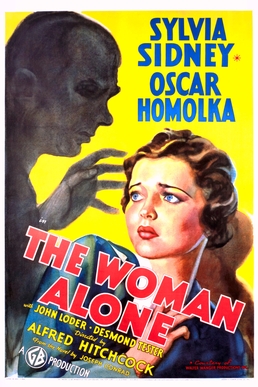 |
| Sabotage poster with the original title for the U.S. release |
In one of the coldest-hearted scenes ever put on film, a young boy plays with a puppy held by a woman seated next to him on a London bus, and then they are blown to bits by the bomb he has unwittingly been carrying. The scene would be less shocking if we hadn't spent a good part of the movie getting to know Stevie (Desmond Tester), the younger brother of Mrs. Verloc (Sylvia Sidney), whose husband (Oskar Homolka) belongs to a terrorist group. We have seen Stevie carrying his lethal package, which Verloc has commissioned him to leave at a specific location by a certain time, and we have grown fond of him when he is detained by a street hawker selling toothpaste and hair tonic and pauses to watch a parade. As the fatal time grows closer, we feel sure that something will happen to defuse the bomb, as usually happens in movies, so its detonation comes as a reversal of movie convention, one so radical that even Hitchcock will not attempt anything quite like it until he kills off the star of
Psycho in mid-film 24 years later. (Even then, he will not do anything so sadistic as add a puppy to the scene.)
Sabotage is not one of Hitchcock's more famous movies -- it's often confused with his
Saboteur (1942). But it is, I think, one of his most characteristic because of his willingness to violate convention. The film is based on Joseph Conrad's
The Secret Agent -- a title he couldn't use because it was the title of his other 1936 release, an adaptation of a Somerset Maugham story that starred John Gielgud and Madeleine Carroll. But
Sabotage is closer to Kafka than to Conrad, a film that verges on the surreal and dreamlike at times. The Verlocs own a movie theater and their home is separated from it by a passageway behind the screen, so that sometimes the sounds from the movies that are playing enter their daily lives. Stunned by Stevie's death, Mrs. Verloc goes out into the theater, where a Disney short, "Who Killed Cock Robin?" is playing, and suddenly begins laughing at the absurd cartoon action. Much else in the film is similarly askew: The bomb-maker, for example, keeps his explosives in ketchup bottles and condiments jars, and when he goes to get the bomb for Verloc, he finds his granddaughter's doll in the cabinet. (If, indeed, she's his granddaughter -- there's much coy mystery about that.) There's an oddball romance between Mrs. Verloc and Ted (John Loder), the Scotland Yard detective who works undercover at the greengrocers' next to the Verlocs' theater, keeping an eye on Verloc. And the ending is a mare's nest of ambiguities that don't lend themselves to summary. What keeps the movie from descending into incoherence is Hitchcock's sure sense of style and the occasionally expressionistic cinematography of Bernard Knowles. Later, Hitchcock would regret the way he handled Stevie's death, but it remains consistent with the haunting effect of the film as a whole.


